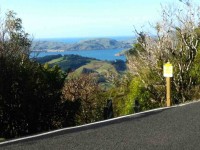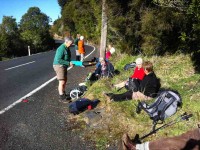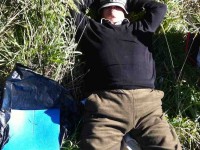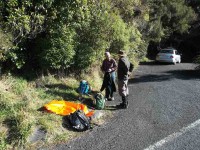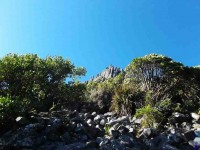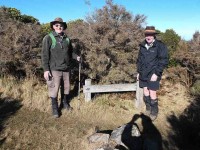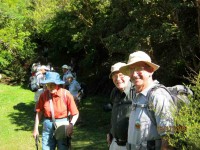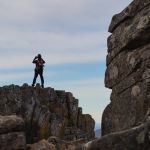 25/06/2025. Grahams Bush, Organ Pipes, Buttars Peak. Grade 4. Trampers. Leaders: Phil Morris, Rod Ward.
25/06/2025. Grahams Bush, Organ Pipes, Buttars Peak. Grade 4. Trampers. Leaders: Phil Morris, Rod Ward.
We left 9.30 from PJ Park travelling to Sawyers Bay, to the end of Hall Road, meeting up with townies with really good numbers (26) at 10.10am.
Continue reading “Grahams Bush Track, Organ Pipes, Buttars Peak”
Tag: Grahams Bush
Graham’s Bush, Organ Pipes, Buttar’s Peak, Mt Cargill
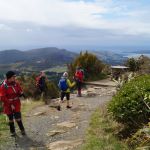 09/10/2024. Graham’s Bush to Mt Cargill. Grade 4. Trampers. Leaders: Karen McInnes and Gail Williams
09/10/2024. Graham’s Bush to Mt Cargill. Grade 4. Trampers. Leaders: Karen McInnes and Gail Williams
Eleven hardy trampers met at the end of Hall Road in Sawyer’s Bay on Wednesday morning, very aware that the weather was dodgy to say the least.
Continue reading “Graham’s Bush, Organ Pipes, Buttar’s Peak, Mt Cargill”
Grahams Bush, Old Main Rd, Organ Pipes, Buttars Peak, Mt Cargill, Mt Cutten
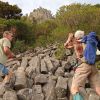 18. 24/04/2024. Hikers. Graham’s Bush/Organ Pipes. Grade 3. 27 km. Leaders: Maria MacNee/Theresa White
18. 24/04/2024. Hikers. Graham’s Bush/Organ Pipes. Grade 3. 27 km. Leaders: Maria MacNee/Theresa White
A twenty-one strong group of hikers met at the rendezvous in Sawyer’s Bay at the Emmanuel Church Car Park. Continue reading “Grahams Bush, Old Main Rd, Organ Pipes, Buttars Peak, Mt Cargill, Mt Cutten”
Grahams Bush, Organ Pipes, Buttars Peak, Mt Cargill – Information and Trips Library
Scope:
This page of club tramps and hikes in the West Harbour area groups together trips to Grahams Bush,(map) the Organ Pipes, Buttars Peak and Mt Cargill.
Background Information:
Road distances from Mosgiel carpark.
TRTC Grading Information – trips incorporating these tracks are generally given a TRTC grading of 4. This is indicative only, as trips can be allocated a higher or lesser grading depending on the route taken. For more detailed analysis refer to Grading Information.
Grahams Bush Botanical Information (1988) (from DoC information sheet).
Mt Cargill – Information (from DoC information sheet).
How To Get There:
Take SH88 to Port Chalmers. At Sawyers Bay turn left onto Station Road and continue on this road through the roundabout and onto Hall Road. At the end of Hall Road there is a sign indicating the track and an area for limited parking.
Links to tramps and hikes in the same area:
25/06/2025. Grahams Bush, Organ Pipes, Buttars Peak. Grade 4. Trampers. Leaders: Phil Morris, Rod Ward.
09/10/2024. Graham’s Bush to Mt Cargill. Grade 4. Trampers. Leaders: Karen McInnes and Gail Williams
Grahams Bush, Old Main Rd, Organ Pipes, Buttars Peak, Mt Cargill, Mt Cutten, Bethunes Gully, Upper Junction (2024 – 1989, 18 trips with 11 reports).
Grahams Bush, Upper Junction, Brickhill Rd (2014 – 1993, 15 trips with 4 reports).
Grahams Bush, Careys Bay (2004, 1 trip, no report).
From Old Mount Cargill Road Lookout (1992, 1 trip, no report)
Grahams Bush, Upper Junction, Brickhill Rd
Parking: Church Grounds. Distance from car-park: 27 km.
After morning tea, with still no sign of the hikers, we walked to the top road,
The return trip was uneventful, & the birds once again kept us company. – Ian Hebberd? – per Ken.
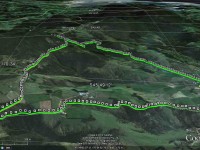
10.5 km distance.
3.7km/h moving ave.
2hr 48min moving time.
379mtrs. total ascent.
394 max elevation.
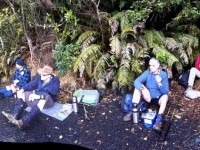
Continue reading “Grahams Bush, Upper Junction, Brickhill Rd”
Grahams Bush Botanical Information (1988)
It is also interesting to note how dry this slope is. This stands in sharp contrast to the cooler gully at the bottom of the hill. A bridge spans the creek here, about 20-30 minutes from the carpark. Beyond this are more mature patches of forest.
Fuchsia (with orange bark) predominates in this valley, while little kanuka can been seen. A good variety of ferns thrive here in the moist conditions, the most distinctive of which are the tall tree ferns. The one with milky-coloured frond stalks is the silver tree fern.
Just 2-3 minutes beyond the bridge is a clearing. From it the hill just descended is apparent. More of the story becomes obvious. The whole hillside is of an even aged kanuka. Above nearer the road one sees old macrocarpas.
Kanuka and manuka often thrive after fire or in areas cleared either by humans or nature. Could it be that this hillside was once cleared, and that maybe the macrocarpas indicate an old homestead site – a base for a farm now abandoned and reverting to native forest?
In such a role kanuka is a successional species; i.e. it thrives after disturbance allows light into the forest floor. In time it gets over-topped by other forest species and becomes replaced with more mature forest.
An example of this mature forest that once covered this hill and what will once again be seen is 10 minutes further down the track.
One cannot fail to be impressed by the huge boles in the rimus (with hammer bark) and miros (with soft green leaves and dark mossy trunks). These giants are survivors of a once extensive podocarp forest that covered most of the Dunedin district. Fortunately their poor shape precluded their being logged for timber and consequently they now serve as a seed source to re-vegetate the reserve in podocarps. The dominant trees forming the forest canopy in this area are kanuka.
A second small patch of these trees occurs a little below the second bridge. Beyond them further evidence of the impact of humans on the area is seen – hawthorns growing in the forest! These exotic trees from Europe add a new shade of green to the forest each spring. Being deciduous, like so many continental trees, they lose their leaves in summer and grow a new set in spring. In New Zealand the only common tree with this habit is the fuchsia – the orange shaggy-bark trees. Like kanuka, fuchsia is one of those successional species. Their roles are very similar but they fill them in different locations – fuchsia preferring damper cooler sites.
– Adapted from DoC hard-copy information sheet

